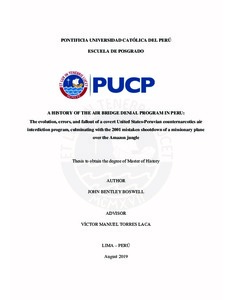A history of the air bridge denial program in Peru: the evolution, errors, and fallout of a covert United States-Peruvian counternarcotics air interdiction program, culminating with the 2001 mistaken shootdown of a missionary plane over the Amazon jungle
Abstract
During the 1990s, the Governments of Peru and the United States established a
counternarcotics air interdiction program called Air Bridge Denial over the Peruvian Amazon.
During this program the United States Central Intelligence Agency conducted surveillance
missions over Peru’s coca growing regions, and passed suspicious aircraft location data to the
Peruvian Air Force, who would then intercept the suspected narcotrafficking aircraft and force
them to land or be shot down. The program was interrupted in 2001 following the accidental
shootdown of a missionary floatplane over Peru, which resulted in the deaths of two United
States citizens. This thesis examines the development, operations, and fallout of Air Bridge
Denial in Peru, including its patterns of errors, complexities and challenges such as binational
interoperability, bilingual communications failures, neglect of mandatory protocols, and poor
oversight. In examining the detailed history of Air Bridge Denial, this thesis strives to present
lessons learned for the development and implementation of any similar programs in the future.
Disclaimer: The views in this paper are strictly those of the author, and do not necessarily
reflect the official views of the U.S. Government, the Department of Defense, or any of its
agencies, nor the Olmsted Foundation. Moreover, all of the government sources used for this
thesis are from open source and unclassified public archives, and from sources readily available
to the public through open web searches and periodicals, including documents released under the
U.S. Freedom of Information Act (FOIA). This is in fact an admitted limitation to the study, as
there may be additional government information, included classified archives, from both the U.S.
and Peru that might provide greater detail and insight. The author does not know this to be a fact
or not. The publicly available information at hand may at least help fill gaps in the historical
academic record surrounding the program, and open the door for continued study on the topic.
Temas
Narcotráfico--Perú
Control de drogas--Perú
Narcotráfico--Investigación
Narcotráfico--Política gubernamental--Estados Unidos
Control de drogas--Perú
Narcotráfico--Investigación
Narcotráfico--Política gubernamental--Estados Unidos
Para optar el título de
Maestro en Historia
Collections
The following license files are associated with this item:






